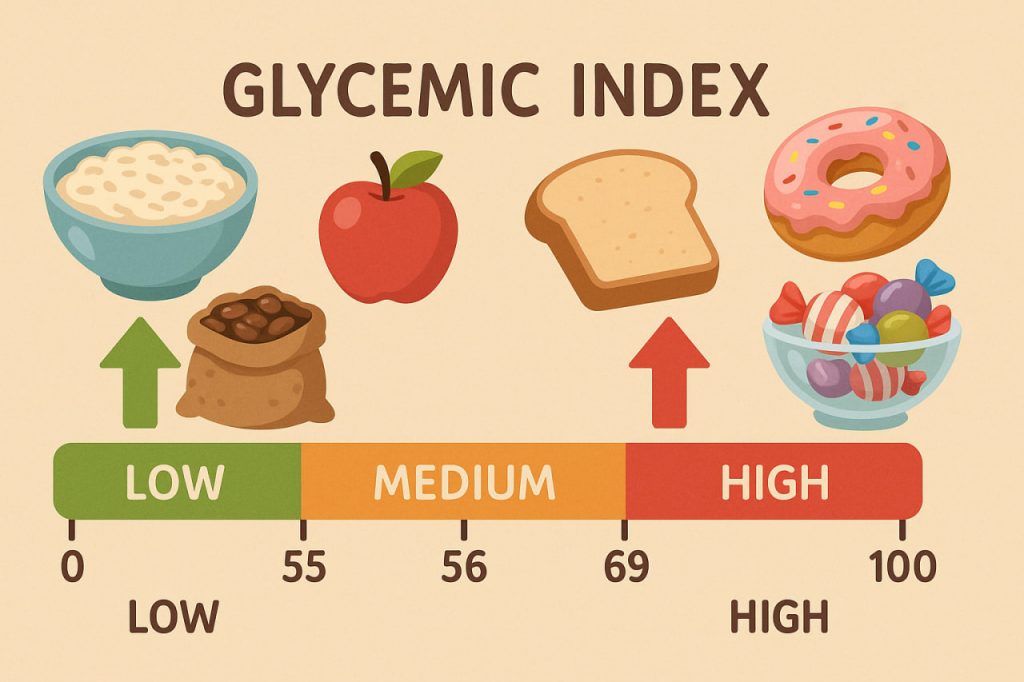The glycemic index (GI) is one of the most important concepts in modern nutrition. It helps us understand how quickly different foods raise blood sugar levels after eating. For anyone who cares about energy, weight management, or long-term health, learning how to use the glycemic index can make a major difference in daily diet choices and overall well-being.
What Is the Glycemic Index?
The glycemic index ranks foods containing carbohydrates on a scale from 0 to 100, depending on how fast they increase glucose (sugar) levels in the blood. The higher the number, the faster the body converts that food into glucose.
- Low GI (0–55): Foods that raise blood sugar slowly and steadily.
- Medium GI (56–69): Foods that have a moderate effect.
- High GI (70–100): Foods that cause a rapid spike in blood sugar.
For example, pure glucose has a GI of 100, while lentils and oats have much lower values, usually around 30–40.
Why the Glycemic Index Matters
When blood sugar rises too quickly, the body releases insulin to store excess glucose. Frequent spikes and crashes lead to fatigue, hunger, and eventually insulin resistance, which can increase the risk of type 2 diabetes, obesity, and heart disease.
Eating low-GI foods provides:
- Steady energy throughout the day.
- Better appetite control and reduced sugar cravings.
- Improved metabolism and fat-burning capacity.
- Lower risk of chronic diseases related to high blood sugar.
Factors That Influence the Glycemic Index
The GI of a food depends on several key factors:
- Type of carbohydrate: Complex carbohydrates (like in whole grains) break down slower than simple sugars.
- Fiber content: Fiber slows digestion and lowers GI.
- Fat and protein: Adding fat or protein to a meal reduces the overall GI.
- Cooking method: The longer a food is cooked, the higher its GI — for example, overcooked pasta releases sugar faster.
- Ripeness: Ripe fruits have a higher GI than unripe ones due to increased sugar content.
Examples of Foods by Glycemic Index
| GI Category | Food Examples | Glycemic Index |
|---|---|---|
| Low GI (0–55) | Lentils, beans, apples, oats, whole-grain bread, yogurt | 25–55 |
| Medium GI (56–69) | Brown rice, sweet potatoes, couscous, pineapple | 56–69 |
| High GI (70–100) | White bread, sugary drinks, potatoes, white rice | 70–100 |
The Glycemic Load: A More Complete Picture
The glycemic load (GL) combines the GI with the actual carbohydrate amount in a serving. It gives a more realistic idea of how a typical portion affects blood sugar.
- Low GL: under 10
- Medium GL: 11–19
- High GL: 20 and above
For example, watermelon has a high GI (72) but a low GL (4), because it contains very little carbohydrate per serving.
Practical Tips for a Low-GI Diet
- Choose whole grains instead of refined ones (brown rice, quinoa, oats).
- Eat more fiber from vegetables, legumes, and seeds.
- Combine carbs with protein or healthy fats (like nuts, olive oil, or fish).
- Avoid sugary drinks and white flour products.
- Cook pasta and grains al dente for lower GI.
- Add vinegar or lemon juice — they help reduce the glycemic impact of meals.
Health Benefits of a Low-GI Diet
Research shows that maintaining a diet rich in low-GI foods:
- Reduces the risk of type 2 diabetes and metabolic syndrome.
- Improves cholesterol levels and heart health.
- Stabilizes mood and focus by preventing sugar crashes.
- Supports weight control by reducing hunger and overeating.
Limitations of the Glycemic Index
While GI is useful, it shouldn’t be the only factor in food choice. For instance, watermelon has a high GI but is still healthy, while chocolate has a low GI but contains high fat and sugar. The nutritional quality of the food matters just as much as its glycemic value.
Interesting Facts
- The glycemic index was first developed in the early 1980s by Dr. David Jenkins at the University of Toronto.
- Raw carrots have a GI of about 35, but when cooked, it rises to around 50.
- The GI of rice can vary from 40 to 90, depending on its variety and cooking time.
- Adding lemon juice or vinegar to rice or bread can lower their GI by up to 30%.
Glossary
- Glucose — the main form of sugar in the blood, used by cells for energy.
- Insulin — a hormone that regulates blood sugar levels.
- Complex carbohydrates — slow-digesting carbs found in whole grains and legumes.
- Glycemic load (GL) — a measure that accounts for both the quantity and quality of carbohydrates.
- Metabolic syndrome — a cluster of conditions including obesity, high blood pressure, and insulin resistance.


